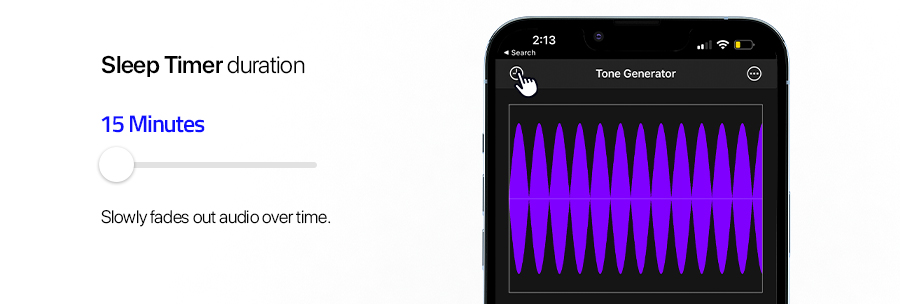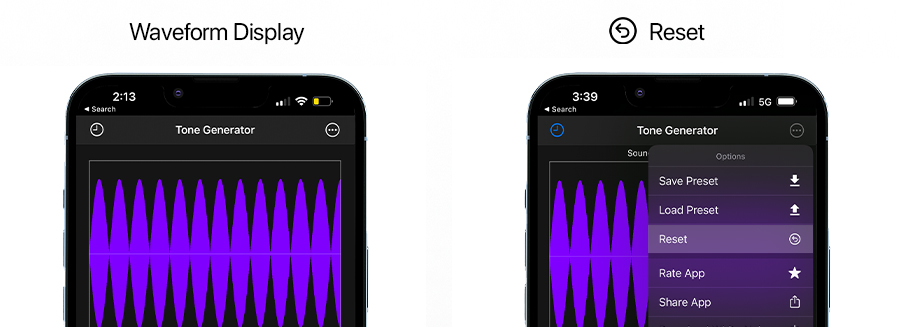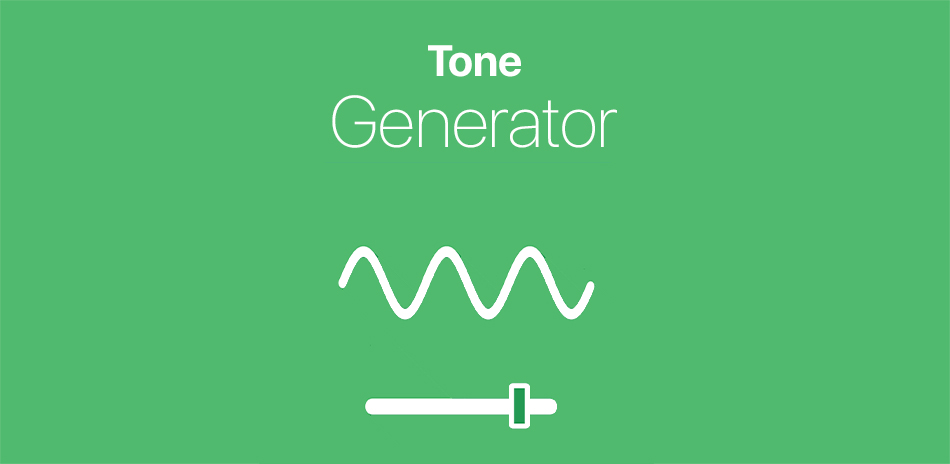Although our Generator apps has been out for some time, almost five years to be exact, we thought we’d share the inside scoop on how to get the most out of the Tone Generator app and some recent updates we’ve made.
In the Tone Generator app, the sound of the tone is determined by the frequency. Frequencies are measured in Hz which means one cycle of a sine wave per second (from zero crossing to peak, valley, and then back). A higher frequency means a higher note or tone.

Frequency Slider
This slider controls the frequency in Hz of the tone played. Moving the slider to the right increases the frequency of the tone and moving left decreases the frequency. The limits of human hearing is between 20 Hz and 20,000 Hz. The default frequency is 200 Hz.
Many mobile phone speakers and devices have difficulty producing lower frequencies so tones below 50 Hz may be inaudible or difficult to hear depending on the listening device. The average adult hearing limit is around 16,000 Hz at the high end so frequencies above that threshold may be inaudible to the listener no matter the speaker type.
Sleep Timer
We’re excited about this feature recently added to the app. For most purposes, listening for 10-30 minutes appears to be enough to achieve desired benefits. And now the Sleep Timer can help with that. Users can set the sleep timer between 15 minutes and 8 hours, in 15 minute increments. Just like our White Noise app, this function allows for a gentle fading out of audio over the last minute of playtime.

Presets
Another new feature to the Tone Generator app is the ability to have up to 5 Preset combinations. This was requested by numerous users and we agree, it makes for a much more convenient user experience! Once you have the tone Frequency and Balance set to your liking, tap the menu button at the top right of your screen, tap ‘Save Preset’, choose from one of the five preset options, then either tap ‘Save’ or enter a custom name for your new favorite then tap ‘Save’.
Reset
The Reset button is a new feature that resets all settings except volume to default and generates a new random waveform.
Waveform Display
The Waveform Display shows the waveform of the current audio signal, changing in color and waveform to match each setting.

Healing Frequencies in Popular Culture
Some anecdotal reports suggest a variety of frequencies that are said to have certain properties and associations. To date there have been no studies in peer reviewed scientific journals confirming the efficacy of these frequencies, however many people swear by the effects.
Solfeggio Frequencies
Solfeggio frequencies are sometimes claimed to be ancient frequencies based on numerology and are ascribed different healing powers. Solfeggio was a 6 note scale developed by the monk Guido d’Arezzo for teaching and transcribing music. There are, however, few (if any) historical references to specific frequencies. The numerical values for the solfeggio frequencies have been said to originate from Dr. Joseph Puleo as derived from pattern based numerological calculations said to be extracted from bible verses. In popular culture one tone, Ti, was added to the original 6.
Ut – 396 Hz tone believed to be associated with ridding oneself of guilt and fear, said to balance Root Chakra
Re – 417 Hz tone believed to be associated with positive change and undoing of negative changes, said to balance Sacral Chakra
Mi – 528 Hz tone believed to be associated with self transformation, reducing stress, increasing confidence, said to balance the Solar Plexus Chakra
Fa – 639 Hz tone believed to be associated with enhancing relationships, communication, and personal connections, said to balance the Heart Chakra
Sol – believed to be associated with intuition, problem solving, and self expression, said to purify the mind and body, said to balance the Throat Chakra
La – 852 Hz tone believed to be associated with spirituality and intuition, said to balance Third Eye Chakra
Ti – 963 Hz believed to be associated with oneness, enlightenment, perfection, said to balance Crown Chakra
432 Hz
Throughout most of history music did not have a common reference for tuning and so various tuning standards were used. In most modern western music the tuning A = 440 Hz is used. Early tuning forks (from the 18th century) have frequencies between 400-420 Hz and the reference frequencies kept rising, partially as a way for composers to sound more unique and exciting. Eventually in the mid 19th century the 440 Hz standard was adopted, originating from an agreement between the French and English governments. It wasn’t until the 1920’s that American instrument manufacturers chose 440 Hz as the standard for new instruments, solidifying its reign.
So where does the popular 432 Hz frequency come from? The Italian composer Guisseppe Verdi. Verdi chose this pitch because he saw it as easier to tune to and less straining on singers.
Though likely practical in origin some believe that a 432 Hz frequency opens the Chakras and brings relaxation. It is also claimed that this frequency is related to sacred geometry and the origins of the universe. The power of this frequency is said to be related to the Schumann Resonance. The Schumann Resonance is the fundamental frequency of electromagnetic waves on earth after being struck by lightning. Some attribute this as being the fundamental frequency of the earth. The true Schumann frequency is actually a low, inaudible tone of 7.86 Hz but proponents of the benefits of 432 Hz often round this number up to 8 which creates 432 Hz at its 5th octave.
